Farmhouse Living Room Ideas
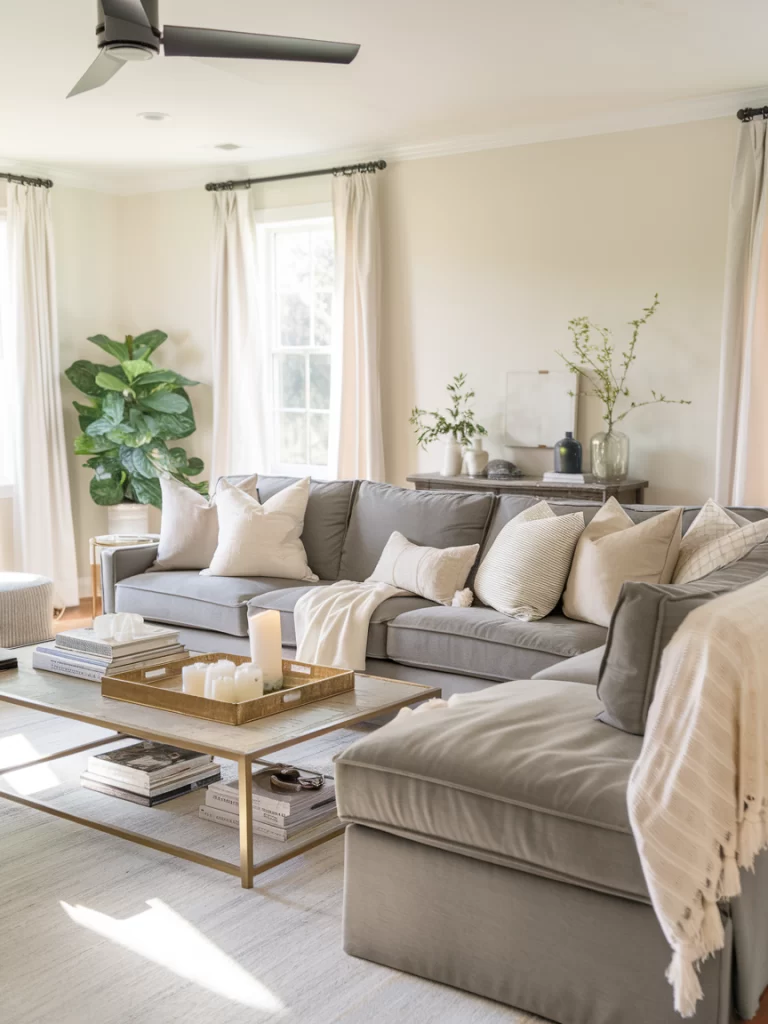
Farmhouse Living Room Ideas – Bringing Rural Charm to Your City Living Room

The classic image of farmhouse style often conjures visions of expansive living rooms with soaring beamed ceilings, massive stone fireplaces, and sprawling sectional sofas. But for those of us dwelling in urban apartments or compact townhomes, capturing that coveted farmhouse aesthetic requires a more nuanced approach. The good news? Farmhouse decor in your living room isn’t about square footage—it’s about creating an atmosphere of warmth, simplicity, and connection to a more relaxed way of life.
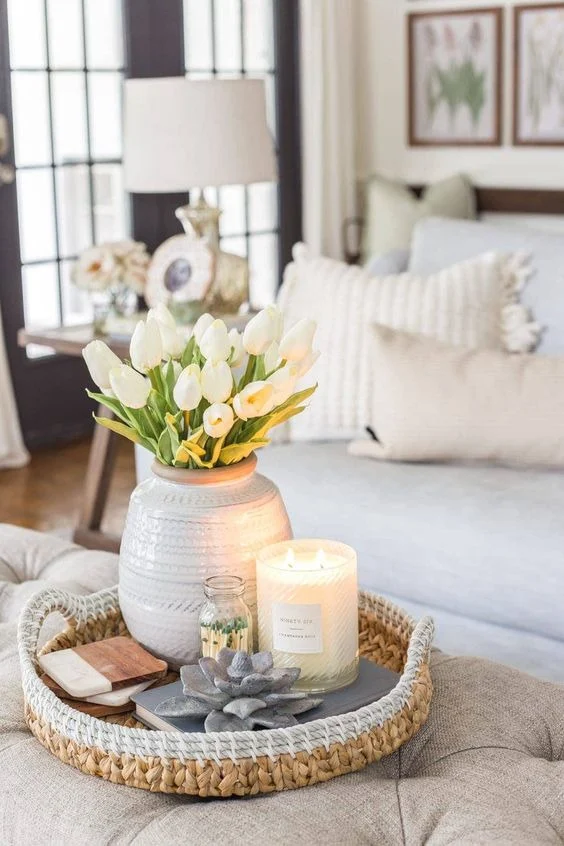
Creating architectural interest becomes an art form in urban living rooms where original character may be scarce. Rather than lamenting the lack of exposed beams or wide-plank floors, city dwellers are finding innovative ways to infuse farmhouse charm into basic spaces. A carefully chosen collection of vintage mirrors can add depth while bouncing precious natural light throughout the room. Substantial wooden floating shelves, installed with iron brackets, bring architectural gravitas to plain walls while providing display space for cherished collections.
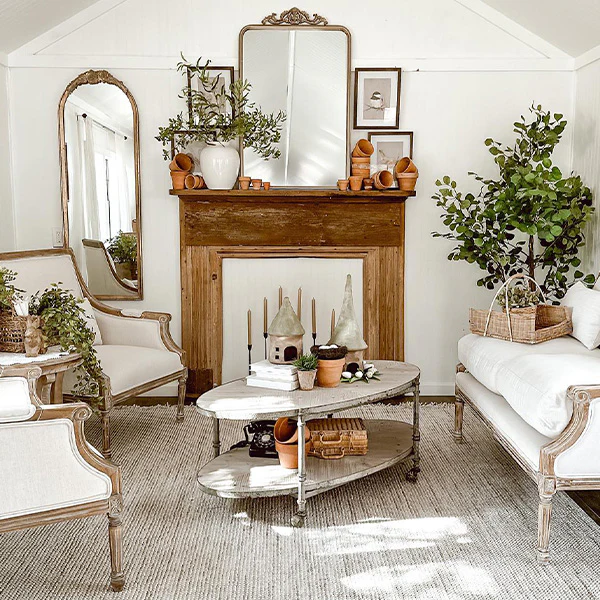
The magic of farmhouse decor in a city living room lies in understanding scale and proportion. While traditional farmhouse spaces might accommodate oversized furniture pieces, urban rooms demand a more edited approach. A loveseat upholstered in natural linen paired with a compact leather armchair can provide the same inviting conversation area as a large sectional. Wall-mounted lighting fixtures free up valuable floor space while adding authentic period character.

Texture plays a starring role in successful urban farmhouse living rooms. The interplay of smooth and rough, polished and weathered, creates visual interest without requiring extra square footage. Picture a smooth leather ottoman contrasting with a nubby wool throw, or crisp linen curtains filtering light onto a distressed wood coffee table. These layered textures add depth and sophistication to even the smallest spaces.
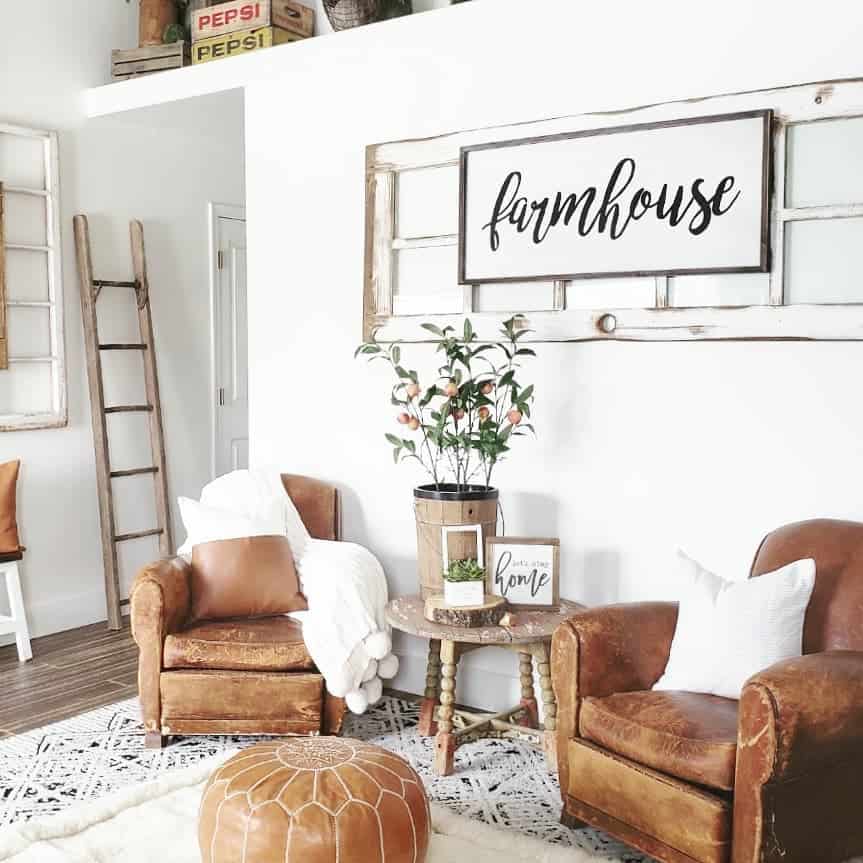
Natural light becomes particularly precious in urban settings, where windows may be limited by neighboring buildings or apartment layouts. Farmhouse decor thrives on brightness, making light manipulation crucial in city spaces. Strategic mirror placement can dramatically increase the perception of light and space. Choosing warm white paint colors for walls creates a bright but welcoming backdrop that honors farmhouse traditions while maximizing available light.
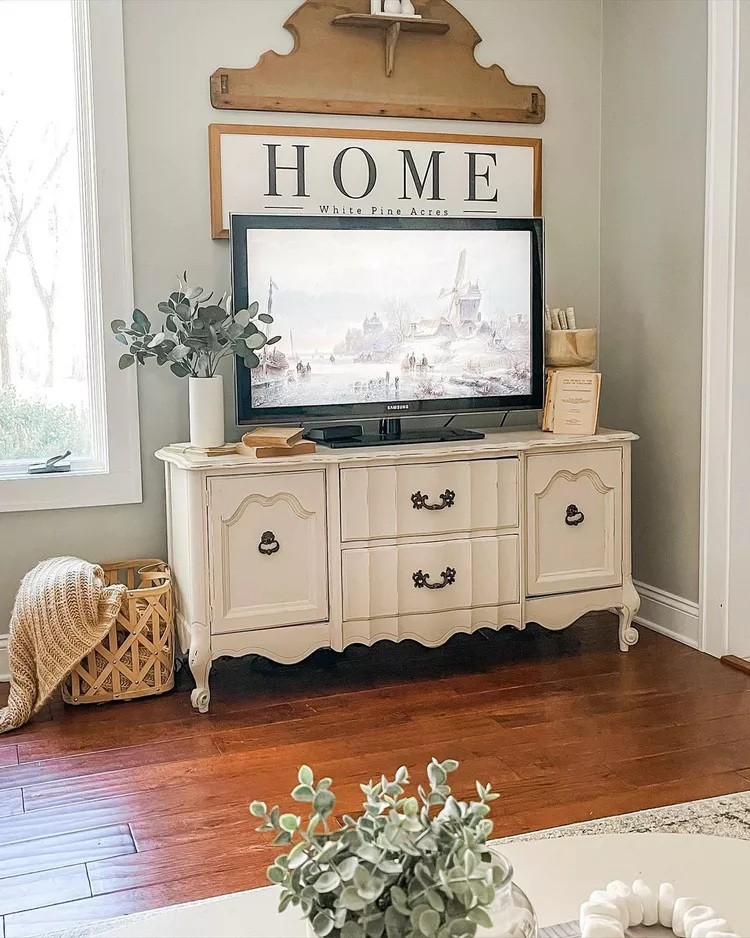
The beauty of modern farmhouse decor lies in its ability to embrace both past and present. Today’s urban interpretation doesn’t require sacrificing contemporary comforts or technology. A sleek smart TV can coexist harmoniously with vintage architectural salvage when thoughtfully integrated. Modern art takes on new meaning when framed in weathered wood, while streamlined furniture pieces feel right at home alongside antique accessories.

Storage solutions become an integral part of the design story in urban farmhouse living rooms. Instead of hiding storage away, the style celebrates beautiful utility. A vintage trunk serves double duty as a coffee table and blanket storage, while a repurposed cabinet with glass doors displays books and treasures while maintaining visual lightness.
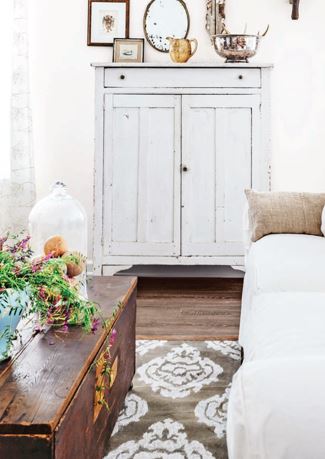
Perhaps most importantly, urban farmhouse decor reminds us that authenticity matters more than square footage. Your city living room might not have a wood-burning fireplace or views of rolling fields, but it can still capture the essence of farmhouse style—comfort, practicality, and personal connection. By thoughtfully adapting rural design elements to urban realities, you create a space that honors farmhouse traditions while celebrating modern city living.
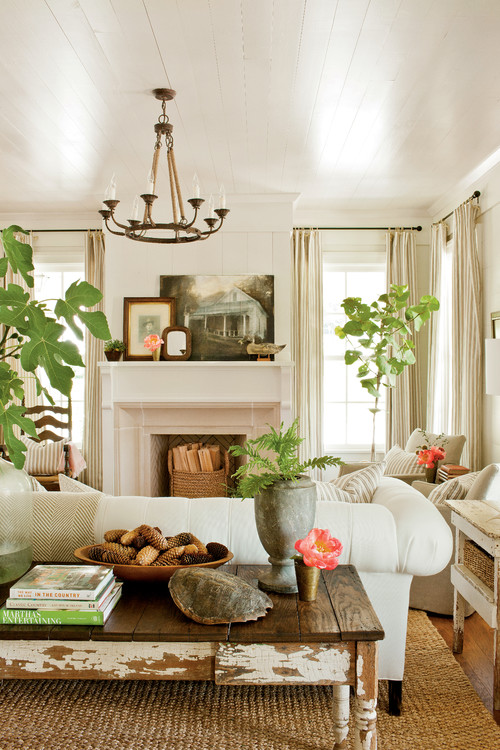
The result is a living room that feels both timeless and timely, proving that farmhouse style isn’t limited by location but defined by the warmth and welcome it creates. Whether you’re hosting friends for movie night or enjoying a quiet evening with a book, your urban farmhouse living room becomes a testament to the enduring appeal of rural charm, reimagined for city life.
Farmhouse Living Room Guide
A farmhouse living room blends comfort, simplicity, and timeless design to create a space that feels both inviting and practical. You can achieve this look by focusing on natural textures, warm colors, and furniture that balances rustic charm with everyday function. With the right choices, your living room can feel cozy without being cluttered and stylish without losing its relaxed appeal.
This guide walks you through the foundations of farmhouse style, from the key design elements to the small details that make the biggest impact. You’ll explore layout ideas, furniture choices, and ways to layer textures like wood, linen, and stone for a room that feels both lived-in and refined.
Along the way, you’ll also find inspiration in ten farmhouse living room ideas that highlight how to mix tradition with modern comfort. By the end, you’ll know how to create a space that reflects your own style while keeping the warmth and character that define farmhouse living.
Foundations of Farmhouse Living Room Style
A farmhouse living room blends comfort with practicality by using natural textures, timeless furniture, and a warm color scheme. You create balance by mixing rustic design details with clean, modern touches that keep the space inviting and functional.
Defining Farmhouse Style
Farmhouse style focuses on comfort, simplicity, and function. It draws from traditional rural homes where furniture and decor were chosen for durability and usefulness. You see this influence in sturdy wood tables, soft textiles, and pieces that look lived-in rather than polished.
This design often mixes old and new. A vintage trunk can sit next to a modern sofa, and both still feel at home in the same space. Instead of chasing trends, you build a room that feels timeless and personal.
Farmhouse style also values authenticity. Real wood, stone, and metal are preferred over synthetic materials. When you use natural finishes, the room feels grounded and connected to its roots in rural living.
Key Elements of Farmhouse Living Rooms
A farmhouse living room usually includes a few core features that make the space recognizable. Shiplap walls, barn doors, and exposed beams are common architectural details that add rustic character.
Furniture is often oversized and comfortable. You might choose a deep sofa with slipcovers, a reclaimed wood coffee table, or a mix of antique and new chairs. These pieces keep the room casual and welcoming.
Decor plays a big role in farmhouse design. Woven baskets, ceramic vases, and textured throw blankets add depth without clutter. A fireplace, especially one framed with stone or brick, often becomes the focal point of the room.
Color Palettes and Wood Tones
The color scheme in a farmhouse living room usually leans toward neutral shades. Warm whites, soft grays, and beige tones create a calm backdrop. You can layer in muted accent colors, such as sage green, dusty blue, or terracotta, through pillows, rugs, or small decor pieces.
Wood tones are essential to farmhouse design. Lighter woods like oak or pine bring brightness, while darker options such as walnut or reclaimed barn wood add contrast. A mix of finishes—painted, stained, or weathered—creates a natural, lived-in look.
To keep balance, combine smooth painted surfaces with rougher textures like raw wood or stone. This contrast highlights the rustic design while keeping the room from feeling flat.
Farmhouse Living Room Ideas: Top 10 Inspirations
The right mix of textures, finishes, and furniture can turn your space into a warm and practical farmhouse living room. Focusing on natural materials, comfortable seating, and layered details helps you create a room that feels both inviting and functional.
Shiplap Walls and Ceiling Treatments
Shiplap is one of the most recognizable features in farmhouse living rooms. You can use it on walls or ceilings to add subtle texture without overwhelming the space. Painted white shiplap creates a bright backdrop, while natural or stained boards bring warmth and depth.
Installing shiplap horizontally can make a room feel wider, while vertical boards draw the eye upward. On ceilings, shiplap pairs well with exposed beams, adding architectural interest that feels timeless.
You don’t need to cover every wall. An accent wall behind a sofa or fireplace is often enough to highlight the farmhouse look. Shiplap also works with both rustic and modern farmhouse styles, making it versatile for different design preferences.
Incorporating Slipcovered Sofas
A slipcovered sofa gives you comfort, flexibility, and easy maintenance. Cotton and linen covers in neutral tones like white, beige, or gray fit seamlessly into farmhouse living rooms. These fabrics soften the space and complement natural wood furniture and metal accents.
Slipcovers are practical because you can remove and wash them, which is useful in high-traffic areas or homes with kids and pets. If you want a fresh look, you can swap slipcovers seasonally without replacing the whole sofa.
Pair your slipcovered sofa with oversized throw pillows or knitted blankets. This layering adds texture and makes the seating area feel more relaxed. A slipcovered sofa also blends well with vintage or reclaimed pieces, keeping the farmhouse style consistent.
Layered Rugs for Warmth and Texture
Layering rugs is a simple way to add depth and comfort to your living room. Start with a large neutral base rug, such as jute or sisal, to ground the space. Then place a smaller patterned or textured rug on top to bring in color and visual interest.
This approach works well in open floor plans because it defines seating areas without using walls. It also adds softness underfoot, which balances the harder surfaces like wood floors or stone fireplaces often found in farmhouse homes.
Layered rugs also let you mix materials. For example:
- Base layer: Jute or sisal for durability
- Top layer: Wool or cotton for softness and pattern
This combination gives your living room a cozy, lived-in feel while still looking intentional and polished.
Furniture and Layout Choices
The furniture you pick and how you arrange it shapes the comfort and function of your farmhouse living room. Balance is key—choose pieces that feel inviting, arrange them for easy conversation, and consider how dining and lounging areas can work together in one space.
Choosing the Right Sofa: Chesterfield and More
Your sofa sets the tone for the entire room. A Chesterfield sofa, with its tufted back and rolled arms, adds timeless character that works well in both rustic and modern farmhouse settings. Its structured design pairs nicely with soft textiles like linen throws or cotton pillows, which keep the look relaxed rather than formal.
If you prefer something more casual, a slipcovered sofa in neutral tones offers flexibility. You can wash or replace the cover, which is practical in a busy household. Sectionals also work well in larger spaces, giving you plenty of seating without crowding the room.
To keep the style cohesive, choose upholstery in natural fabrics like linen, cotton, or leather. Neutral shades such as beige, gray, or warm brown blend easily with farmhouse palettes, while muted plaids or subtle stripes can add variety without overwhelming the space.
Arranging for Comfort and Conversation
The way you place your furniture affects how people use the room. Center your seating around a focal point, such as a fireplace, wood stove, or large coffee table. This makes the space feel grounded and encourages conversation.
Arrange chairs or loveseats across from the sofa instead of pushing everything against the walls. This creates a cozy grouping where people can face each other, making the room feel more inviting.
Use side tables and floor lamps to fill gaps and provide function. A simple layout might look like this:
| Piece | Placement Idea |
|---|---|
| Sofa | Facing fireplace or main wall |
| Two armchairs | Across from sofa, angled inward |
| Coffee table | Centered between seating pieces |
| Side tables | Next to sofa or chairs |
This approach keeps the room open while still feeling connected.
Dining Nook Integration
In many farmhouse homes, the living area flows into the dining space. A dining nook can make this transition feel natural while saving space. Built-in benches or a small round table tucked into a corner create a casual spot for meals without overwhelming the room.
You can define the nook with a rug or pendant light to separate it visually from the seating area. Using similar wood tones or upholstery fabrics in both areas ties the look together and prevents the spaces from feeling disconnected.
If you prefer a modern farmhouse style, choose a simple table with clean lines and pair it with mixed seating, such as a bench on one side and chairs on the other. This combination keeps the space practical while still feeling warm and personal.
Keep circulation in mind—leave enough room for movement between the living and dining zones. This makes the space functional without sacrificing comfort.
Textures and Materials for a Cozy Atmosphere
The right mix of fabrics, natural pieces, and sturdy finishes creates a farmhouse living room that feels both warm and practical. Soft textiles, organic accents, and subtle metal details each add comfort and character in different ways.
Soft Textures: Cotton and Linen
Cotton and linen are two of the most reliable fabrics for farmhouse style. Both are breathable, soft to the touch, and easy to layer. You can use them for throw pillows, slipcovers, curtains, or blankets to instantly make the room feel more inviting.
Neutral colors like beige, cream, or gray keep the look calm, while muted stripes or checks add a farmhouse pattern without being overwhelming. These fabrics also wash well, which makes them a practical choice for everyday use.
Try mixing smooth linen curtains with a chunky cotton knit throw. This balance of light and heavy textures adds depth without cluttering the space. Using natural fabrics also helps your room feel less formal and more relaxed.
Woven Baskets and Natural Accents
Woven baskets are both decorative and functional. You can use them to store blankets, magazines, or even firewood while keeping the room tidy. Their natural look pairs well with wood floors, stone fireplaces, or exposed beams.
Choose baskets made of rattan, seagrass, or wicker for the most authentic farmhouse feel. Place a large basket by the sofa for throws or use smaller ones on shelves to organize small items.
Other natural accents, such as wood trays, clay vases, or dried flowers, add warmth without making the room feel crowded. These pieces work best in moderation, so a few well-placed items often look better than filling every corner.
Metal Accents and Galvanized Touches
Metal accents bring contrast to the soft and natural textures in a farmhouse living room. You can use black iron curtain rods, bronze light fixtures, or galvanized trays to add structure and balance.
Galvanized metal works especially well in small doses. A galvanized bucket for plants or a wall clock with a weathered finish adds rustic charm without overpowering the space.
Mixing metals can also look appealing if you keep the tones subtle. For example, pair brushed nickel with galvanized steel or iron with warm brass. This creates variety while still keeping the farmhouse look cohesive.
Architectural Features and Decorative Details
Strong architectural choices shape the look and feel of a farmhouse living room. Materials like wood, stone, and metal add texture, while functional details double as design elements that make the space warm and practical.
Barn Doors and Exposed Beams
Barn doors work well when you need to save space or add rustic character. They slide along a track instead of swinging open, which makes them useful in smaller rooms. You can choose reclaimed wood for a weathered look or painted finishes for a more modern farmhouse style.
Exposed beams highlight the ceiling and draw the eye upward. They bring natural texture and a sense of history into the room. Beams can be structural or decorative, depending on your home’s design.
Pairing barn doors with exposed beams creates a balanced mix of vertical and horizontal features. This combination adds depth and emphasizes the farmhouse character without overwhelming the space.
Tip: Use dark-stained beams with lighter walls to create contrast, or keep both light for a softer, airy look.
Stone Fireplaces as Focal Points
A stone fireplace often becomes the main feature of a farmhouse living room. Natural stone adds weight and texture, making the room feel grounded. You can choose rough-cut stone for a rustic look or smooth stone for a cleaner finish.
The fireplace mantel gives you a place to display decor. Wood mantels pair well with stone and tie the fireplace into other wood elements in the room, such as floors or beams.
If you don’t have a working fireplace, you can still use stone veneer for a similar effect. This keeps the farmhouse style without requiring a full build.
Common mantel displays include:
- Framed photos
- Simple greenery
- Candles or lanterns
Open Shelving and Display Ideas
Open shelving helps you showcase everyday items as part of the design. Instead of hiding objects behind closed cabinets, you can use shelves to display books, ceramics, or woven baskets.
Wooden shelves with metal brackets fit well in farmhouse spaces. They bring in both natural and industrial touches. Keep the arrangement simple to avoid clutter, with a mix of functional and decorative pieces.
Floating shelves above a sofa or beside a fireplace can highlight personal items. In larger rooms, you can combine open shelving with built-in cabinets for more storage.
Best items for open shelves:
- Neutral pottery
- Stacked books
- Small plants
- Woven or wire baskets
Personal Touches and Farmhouse Decor
Adding personal details makes a farmhouse living room feel warm and lived-in. Items like antiques, family photos, and a careful mix of old and new decor create a space that feels both stylish and meaningful.
Incorporating Antiques and Vintage Finds
Antiques bring character and authenticity to farmhouse decor. Pieces like weathered trunks, wooden rocking chairs, or iron candle holders add depth and history to your living room. These items often show signs of age, which enhances the rustic charm rather than taking away from it.
You can use a vintage dresser as a TV stand or repurpose an old ladder as a blanket rack. Even small touches, such as antique clocks or enamel pitchers, can make the space feel unique.
When adding antiques, think about balance. Too many large pieces can overwhelm the room, but a few carefully chosen finds can anchor the design. Pair them with neutral walls and natural textures like linen or jute to keep the look cohesive.
Examples of antique accents:
- Wooden crates for storage
- Vintage mirrors with distressed frames
- Worn leather armchairs
- Old farmhouse tables repurposed as coffee tables
Displaying Family Photos
Family photos add a personal layer that makes the space feel like home. Instead of scattering them randomly, group them together to create a gallery wall. Use frames in wood, black, or white finishes to keep the look simple and consistent.
A mix of old and new photos works well. Black-and-white prints can highlight family history, while recent color photos bring in a modern touch. Placing them on open shelves or above a console table keeps them visible without cluttering surfaces.
If you want variety, combine photos with small art prints or pressed botanical pieces. This creates a balanced display that feels curated rather than crowded.
Tips for photo displays:
- Stick to 2–3 frame styles for consistency
- Arrange in a grid or organic cluster
- Mix sizes for visual interest
- Add captions or labels for context
Balancing Old and New Decor
Blending old and new decor keeps your farmhouse living room from feeling dated. Antiques and family heirlooms provide history, but modern pieces add comfort and function. For example, a sleek sofa can sit next to a reclaimed wood coffee table without clashing.
Use modern lighting, like simple black metal fixtures, to contrast with rustic wood beams. Neutral rugs and clean-lined shelving can balance heavier vintage furniture. This mix prevents the space from leaning too rustic or too contemporary.
Think about proportion as well. If you have a large antique cabinet, pair it with lighter modern chairs to avoid a heavy look. The goal is to let each piece stand out without competing.
Ways to mix styles effectively:
- Pair reclaimed wood with modern upholstery
- Use sleek metal lamps with antique side tables
- Combine vintage rugs with clean-lined sofas
- Add modern art alongside framed family photos
